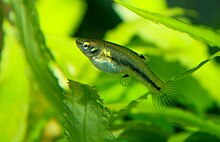Heterandria formosa
| Heterandria formosa | |
|---|---|
 |
|
| Adult female | |
| Scientific classification | |
| Kingdom: | Animalia |
| Phylum: | Chordata |
| Class: | Actinopterygii |
| Order: | Cyprinodontiformes |
| Family: | Poeciliidae |
| Genus: | Heterandria |
| Species: | H. formosa |
| Binomial name | |
|
Heterandria formosa Girard, 1859 |
|
Heterandria formosa (known as the least killifish, mosqu or midget livebearer) is a species of livebearing fish within the family Poeciliidae. This is the same family that includes familiar aquarium fishes such as guppies and mollies. H. formosa is not as commonly kept in aquaria as these species. H. formosa is one of the smallest fish in the world (7th smallest as of 1991[update]), and is the smallest fish found in North America. Despite the common name "least killifish", it belongs to the family Poeciliidae and not to one of the killifish families.
Heterandria formosa is the only member of its genus to be found in the United States. Its range covers southeastern United States, from South Carolina south to Georgia and Florida, and through the Florida Gulf Coast to Louisiana. It is one of the few aquarium fishes to come from North America.
H. formosa lives primarily in vegetated, slow moving or standing freshwater but also occurs in brackish waters.
Heterandria formosa is one of the smallest fish and smallest vertebrates known to science. Males grow to about 2 centimeters (0.8 inches), while females grow a little larger, to about 3 centimeters (1.2 inches).
The fish is generally an olive color, with a dark horizontal stripe through the center of the body. There is also a dark spot on the dorsal fin and females also have a dark spot on their anal fin. Like most poeciliids, males' anal fins are modified into a gonopodium that is used for impregnating females during mating.
...
Wikipedia
